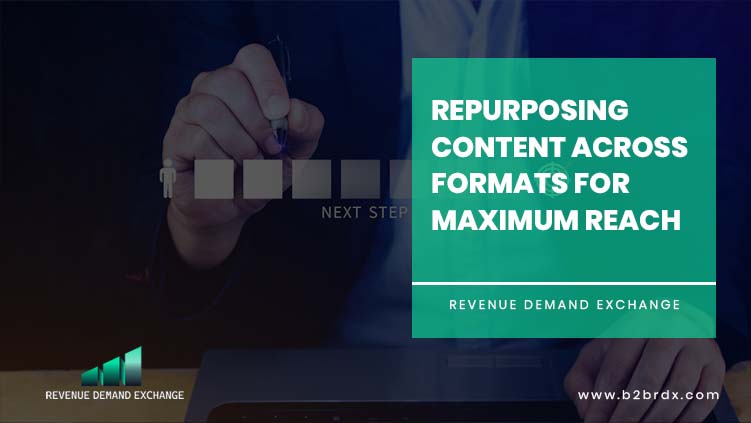Repurposing Content Across Formats for Maximum Reach

In today’s fast-paced digital landscape, brands can’t afford to create content once and let it fade away. Audiences consume information across many platforms—blogs, YouTube, LinkedIn, podcasts, email newsletters, and social media. Repurposing content across formats helps maximize reach, extend the lifespan of your best ideas, and engage different audience segments in ways that match how they prefer to consume information. Done strategically, it saves time, boosts visibility, and amplifies your brand authority.
Understanding the Power of Content Repurposing
Content repurposing means taking an existing piece of content—like a blog post, video, or whitepaper—and adapting it into different formats or for different platforms. The goal isn’t to duplicate but to redistribute your message in new ways that reach new audiences or reinforce key ideas. For example, a long-form blog can become a series of social media posts, a short video script, or an infographic. This approach ensures that every piece of content you create works harder for you, delivering more value from the same idea.
Adapting to Audience Preferences
People consume content differently depending on their interests, habits, and the platforms they use. Some prefer to read in-depth blogs, others like short video explainers, while others might listen to podcasts on the go. By repurposing content into multiple formats, you meet your audience where they already are. For instance, a detailed guide can be turned into a podcast episode for auditory learners or an infographic for visual thinkers. This diversification helps brands connect with a wider audience without constantly creating new material from scratch.
Extending Content Lifespan and Value
Even the best-performing content eventually loses traction over time. Repurposing gives that content a new lease on life. Instead of letting a valuable blog fade into your website archive, it can be transformed into a LinkedIn carousel, a YouTube tutorial, or a newsletter series. Each time you repurpose, you reintroduce your content to new audiences who may have missed it the first time. This not only extends the life of your content but also increases your ROI on the time and resources spent creating it.
Boosting SEO and Online Visibility
Repurposing content isn’t just good for engagement—it’s also powerful for SEO. When you adapt a single topic into multiple pieces across platforms, you create more keyword opportunities, internal links, and backlinks. For example, turning a blog post into a YouTube video with the same topic can help you rank for both text and video search queries. Similarly, sharing snippets or graphics on social media creates new entry points to your main content. This holistic approach strengthens your brand presence and boosts discoverability across search engines.
Maintaining Consistency Across Channels
Repurposing content ensures your brand voice, message, and expertise stay consistent across all marketing channels. Instead of producing unrelated pieces for every platform, repurposing lets you maintain a unified narrative. This strengthens brand recognition and authority. For example, a whitepaper on industry trends can be broken into a webinar, several blog posts, and social media snippets—all sharing the same insights but tailored to the tone and expectations of each platform. Consistency builds trust and helps your audience recognize your expertise no matter where they encounter you.
Leveraging Data to Guide Repurposing Efforts
Not all content deserves repurposing. The key is identifying which pieces perform best and why. Analytics tools can help track engagement, shares, and conversions to pinpoint what resonates most with your audience. High-performing content should be prioritized for repurposing because it already demonstrates strong appeal. For example, if a particular blog gets significant organic traffic, it’s a great candidate to convert into a video or infographic. By basing repurposing decisions on data, you can focus your efforts on what’s most likely to succeed, ensuring maximum reach and impact.
Choosing the Right Formats and Platforms
Each platform and content format serves a unique purpose. The trick is matching your content type to the right channel. Long-form articles work best on your website or LinkedIn, while short clips thrive on TikTok, Instagram, and YouTube Shorts. Podcasts work well for in-depth discussions and interviews, while infographics are ideal for summarizing complex data in a visually appealing way. Repurposing is about strategically adapting—not copy-pasting. You might convert a webinar into a podcast episode, a video summary, and a set of visual quotes for social media—all optimized for each platform’s audience behavior and algorithm.
Saving Time and Resources Through Smart Systems
Repurposing doesn’t just extend your reach—it makes your content creation process more efficient. Instead of starting from zero for every campaign, you can build content systems around key pillars or topics. For instance, one research-heavy blog can fuel an entire week’s worth of marketing assets: a YouTube breakdown, three social media snippets, a LinkedIn post, and an email summary. By building templates and workflows for repurposing, you reduce time spent brainstorming new ideas while maintaining a steady stream of valuable content. This efficiency is crucial for small teams or startups with limited marketing budgets.
Repurposing Evergreen and Seasonal Content
Not all content is created equal—some topics remain relevant year after year (evergreen), while others tie to trends or seasons. Evergreen content, such as “how-to” guides or industry best practices, is perfect for long-term repurposing. You can update and repackage it periodically with fresh data or examples to keep it current. Seasonal or trending content, on the other hand, can be repurposed around similar events each year—like annual reports, product launches, or holidays. This approach ensures you always have something timely to share while reinforcing your authority in recurring themes.
Encouraging Cross-Platform Engagement
When content exists in multiple formats, it naturally encourages cross-platform engagement. For instance, a blog post can drive readers to your YouTube channel for a deeper dive, while a video can include a link back to your blog for additional details. This interconnected ecosystem keeps your audience moving through your brand touchpoints. It also increases retention by allowing people to consume content in the format they find most convenient. The more paths you create for discovery and engagement, the greater your overall reach and influence become.
Conclusion
Repurposing content across formats is more than just recycling—it’s a smart, scalable strategy to amplify your reach, reinforce your brand message, and get the most from every piece of content you create. By adapting to audience preferences, extending the life of your best-performing materials, and optimizing for multiple channels, you ensure your content ecosystem works together rather than in isolation. In a digital world where attention is fragmented and competition is fierce, repurposing helps your brand stay visible, relevant, and resource-efficient. The future of content marketing belongs not just to creators, but to re-creators—those who know how to transform one great idea into many impactful experiences.


